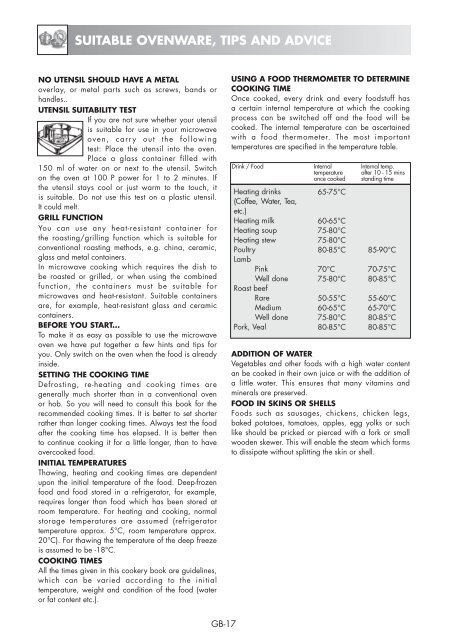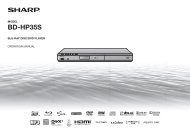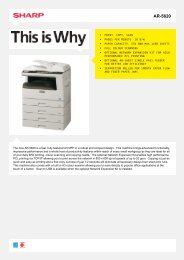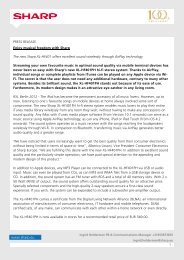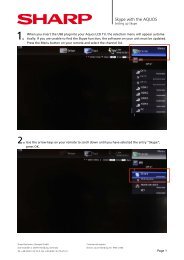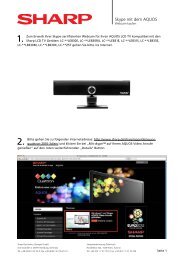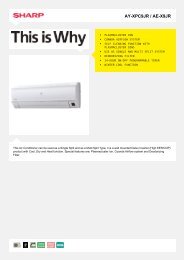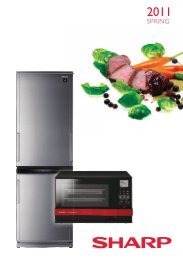R-667-A Operation-Manual GB - Sharp
R-667-A Operation-Manual GB - Sharp
R-667-A Operation-Manual GB - Sharp
Create successful ePaper yourself
Turn your PDF publications into a flip-book with our unique Google optimized e-Paper software.
SUITABLE OVENWARE, TIPS AND ADVICE<br />
NO UTENSIL SHOULD HAVE A METAL<br />
overlay, or metal parts such as screws, bands or<br />
handles..<br />
UTENSIL SUITABILITY TEST<br />
If you are not sure whether your utensil<br />
is suitable for use in your microwave<br />
oven, carry out the following<br />
test: Place the utensil into the oven.<br />
Place a glass container filled with<br />
150 ml of water on or next to the utensil. Switch<br />
on the oven at 100 P power for 1 to 2 minutes. If<br />
the utensil stays cool or just warm to the touch, it<br />
is suitable. Do not use this test on a plastic utensil.<br />
It could melt.<br />
GRILL FUNCTION<br />
You can use any heat-resistant container for<br />
the roasting/grilling function which is suitable for<br />
conventional roasting methods, e.g. china, ceramic,<br />
glass and metal containers.<br />
In microwave cooking which requires the dish to<br />
be roasted or grilled, or when using the combined<br />
function, the containers must be suitable for<br />
microwaves and heat-resistant. Suitable containers<br />
are, for example, heat-resistant glass and ceramic<br />
containers.<br />
BEFORE YOU START...<br />
To make it as easy as possible to use the microwave<br />
oven we have put together a few hints and tips for<br />
you. Only switch on the oven when the food is already<br />
inside.<br />
SETTING THE COOKING TIME<br />
Defrosting, re-heating and cooking times are<br />
generally much shorter than in a conventional oven<br />
or hob. So you will need to consult this book for the<br />
recommended cooking times. It is better to set shorter<br />
rather than longer cooking times. Always test the food<br />
after the cooking time has elapsed. It is better then<br />
to continue cooking it for a little longer, than to have<br />
overcooked food.<br />
INITIAL TEMPERATURES<br />
Thawing, heating and cooking times are dependent<br />
upon the initial temperature of the food. Deep-frozen<br />
food and food stored in a refrigerator, for example,<br />
requires longer than food which has been stored at<br />
room temperature. For heating and cooking, normal<br />
storage temperatures are assumed (refrigerator<br />
temperature approx. 5°C, room temperature approx.<br />
20°C). For thawing the temperature of the deep freeze<br />
is assumed to be -18°C.<br />
COOKING TIMES<br />
All the times given in this cookery book are guidelines,<br />
which can be varied according to the initial<br />
temperature, weight and condition of the food (water<br />
or fat content etc.).<br />
USING A FOOD THERMOMETER TO DETERMINE<br />
COOKING TIME<br />
Once cooked, every drink and every foodstuff has<br />
a certain internal temperature at which the cooking<br />
process can be switched off and the food will be<br />
cooked. The internal temperature can be ascertained<br />
with a food thermometer. The most important<br />
temperatures are specified in the temperature table.<br />
Drink / Food Internal Internal temp.<br />
temperature after 10 - 15 mins<br />
once cooked standing time<br />
Heating drinks<br />
(Coffee, Water, Tea,<br />
etc.)<br />
Heating milk<br />
Heating soup<br />
Heating stew<br />
Poultry<br />
Lamb<br />
Pink<br />
Well done<br />
Roast beef<br />
Rare<br />
Medium<br />
Well done<br />
Pork, Veal<br />
65-75°C<br />
60-65°C<br />
75-80°C<br />
75-80°C<br />
80-85°C<br />
70°C<br />
75-80°C<br />
50-55°C<br />
60-65°C<br />
75-80°C<br />
80-85°C<br />
85-90°C<br />
70-75°C<br />
80-85°C<br />
55-60°C<br />
65-70°C<br />
80-85°C<br />
80-85°C<br />
ADDITION OF WATER<br />
Vegetables and other foods with a high water content<br />
an be cooked in their own juice or with the addition of<br />
a little water. This ensures that many vitamins and<br />
minerals are preserved.<br />
FOOD IN SKINS OR SHELLS<br />
Foods such as sausages, chickens, chicken legs,<br />
baked potatoes, tomatoes, apples, egg yolks or such<br />
like should be pricked or pierced with a fork or small<br />
wooden skewer. This will enable the steam which forms<br />
to dissipate without splitting the skin or shell.<br />
<strong>GB</strong>-17<br />
R-<strong>667</strong>_[EN ckbk].indd <strong>GB</strong>-17<br />
6/2/09 3:01:58 PM


